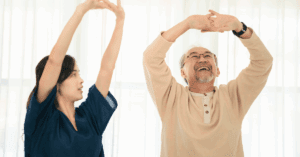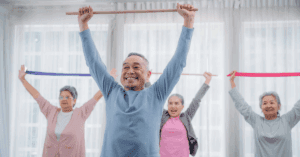
When mobility declines, the effects reach far beyond physical limitations. At our dementia care in Muskego, WI, we see how movement directly supports brain health, especially for those facing memory loss.
Exercise nurtures the mind by increasing blood flow to key brain areas. Active seniors maintain sharper thinking skills longer, while those with memory challenges often experience improved cognitive function through regular movement.
Our balanced exercise programs help residents stay engaged and positive while supporting their cognitive abilities and independence.
How Exercise Supports Emotional Well-being
Movement touches the heart as much as the mind. Regular exercise has been vital to decreasing depression scores and reducing challenging behaviors in people living with dementia. This emotional lift often creates a ripple effect, improving the quality of life for both residents and their caregivers.
Our group activities offer something special beyond physical benefits. We blend movement with cognitive stimulation in a supportive social setting, helping overcome barriers to staying active. These shared experiences rebuild confidence, strengthen community bonds and restore purpose through meaningful movement together.
Exercise Options That Work for Memory Care Residents
Finding the right activities for residents with dementia requires patience. Each person brings unique abilities and challenges, yet certain gentle exercises have proven especially helpful for both cognitive and physical health.
- Chair Yoga and Stretching: We provide seated yoga that accommodates all mobility levels, helping residents improve flexibility while always having support available. Our sessions incorporate calming breathing techniques that visibly reduce anxiety through gentle, mindful movement.
- Balance and Coordination: Through seated marching and supported standing exercises, residents build confidence and strengthen muscles used in everyday activities. These simple movements help prevent falls while encouraging independence in an environment.
- Water-Based Activities: Our water exercises create a forgiving environment where movement feels easier on the body. This approach relieves joint pain and stiffness while combining physical benefits with the emotional joy that comes from comfortable movement despite limitations.
- Light Resistance Training: We help maintain independence through gentle strength building using bands, small weights or body weight exercises. Each session focuses on proper form with careful supervision, enhancing residents’ ability to perform daily tasks.
- Walking Programs: We incorporate this simple yet highly beneficial activity into daily routines, tailoring walks to individual abilities. Using indoor paths and secure gardens, these programs provide a familiar routine and comfort for our residents.
Meeting Every Resident Where They Are
Each person brings unique abilities and challenges to their movement journey. When we thoughtfully adjust activities to match these individual needs, even residents facing significant physical limitations can experience the joy and benefits of meaningful movement.
Our community embraces residents with limited mobility through chair-based exercises like gentle arm circles and seated marching. For those with more restricted movement, we provide bedside stretching and muscle engagement activities. We believe every movement supports memory and physical wellness—no matter how small—helping each resident thrive within their abilities.
Finding the Right Approach: Standing or Seated
Standing cable training versus seated machine exercises found that both approaches improved physical performance in residents, albeit with different benefits. Standing exercises naturally weave in balance components, while seated variations allow focus on isolated strength development.
The good news? Most standing exercises can be adapted for seated performance:
- Keep the same upper body movement while seated
- Adjust resistance levels to match abilities
- Focus on proper form regardless of position
Making Exercise Engaging with Props and Support
Props breathe life into exercise sessions while making them more effective. Resistance bands shine here, offering adjustable tension that works for different strength levels. Other helpful tools include:
- Scarves and streamers for range of motion exercises
- Small weights or weighted balls for resistance
- Balance pillows to improve proprioception
- Chairs or railings for standing support
Regular inspections and clear demonstrations help ensure everyone stays protected while having fun.
Recognizing When to Pause and Adjust
Residents typically experience higher fatigue levels, so careful observation is essential. Morning fatigue significantly affects daily physical activity, with one study showing each point increase on a fatigue scale corresponded with 3.2 fewer minutes of moderate-to-vigorous activity.
Watch for these signs that it’s time to slow down:
- Increased confusion or agitation
- Irregular breathing patterns
- Declining form or coordination
- Verbal expressions of tiredness
Smart session planning includes distinct beginning and ending routines, regular rest periods and the flexibility to modify or wrap up activities when someone needs a break. This approach honors each person’s limits while keeping the door open for future participation. These activities preserve dignity while building moments of joy and accomplishment in each day.
What makes adaptive movement truly special is how it meets people exactly where they are. Someone who needs to remain seated can find just as much benefit and satisfaction as someone who can stand and walk. The focus shifts from limitations to possibilities, from what’s lost to what remains vibrant and alive.
The true power of movement reveals itself in the quiet moments—a smile during stretching, brightened eyes during group activities or hands swaying naturally with music. These precious responses tell the complete story.
Your loved one deserves care that honors both their current abilities and lifelong spirit. Our programs create movement opportunities that feel meaningful at every stage of memory loss. For guidance on how these approaches might benefit your family member, Heritage Senior Living Muskego welcomes your call at (414) 425-7155. Even on challenging days, the right movement activities continue to light up faces and warm hearts.
FAQs
Q1. What types of exercises are suitable for memory care residents? Memory care residents can benefit from gentle exercises such as chair yoga, balance drills, water-based exercises, light resistance training and guided walking sessions. These activities are adaptable to different mobility levels and can improve both physical and cognitive function.
Q2. How does exercise benefit individuals with memory conditions? Regular physical activity can improve cognitive function, especially executive functioning and memory. It also supports emotional well-being by decreasing depression and behavioral symptoms. Additionally, exercise can boost confidence, promote social interaction and create a sense of purpose for memory care residents.
Q3. What are the social benefits of group exercise for memory care residents? Group exercise encourages social interaction, helping to decrease feelings of isolation. Participants often develop camaraderie through shared experiences, creating bonds that extend beyond exercise sessions.


